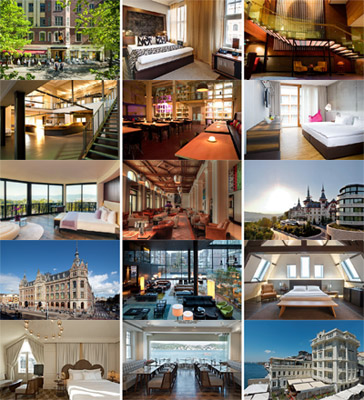Historic Meets Modern: Old Bones Meet New Forms

Historic Meets Modern: Old Bones Meet New Forms
There are places that transport you to the past and places that make you realise the future is here. A rare few are able to achieve this simultaneously. Design Hotels™ invites you to take a
journey around the world, through the ages of time and inspired design, with these five member properties.
www.designhotels.com/historic_meets_modern
Located in a late 19th century building in the design district of Helsinki, Klaus K lives and breathes storytelling in every corner of the concept-driven hotel. Factory Hotel in Münster keeps true to its name by adding just a twist of upscale comfort and elegance to the edgy, concrete walls of the former Germania brewery. The Dolder Grand in Zurich narrates a story of fairytale steeples crowned by current-day compositions. Classical music, historical architecture and Italian design crescendo at Conservatorium Hotel Amsterdam. The cobblestone streets of Istanbul's Ortakoy neighborhood enchant with The House Hotel Bosphorus' allusions to its empirical past while modern design casts its gaze to the future.
A Finnish Fairytale
Set in Helsinki's city center and dating back to 1882, the historic Rake Building and home of Klaus K draws heavily on Finnish folklore. The one time school house brings the treasured national tale of Kalevala to life. An intricate story full of the complexities of life, the Kalevala has spun its way throughout the hotel's 139 rooms, reflecting the emotional themes of mysticism, passion, desire and envy. To ease the romantic era building into the modern day, architects Antti-Matti Siikala and Sarlotta Narjos from SARC Architects together with design storytellers Stylt Trampoli AB, have transformed the landmark into a contemporary oasis. The hotel also features two special rooms designed by renowned Harri Koskinen. 'Urban Nature Room", where the play of textiles, materials and colors are designed to slow the pulse, and the state-of-the-art 'Movie Room", outfitted with the finest in flatscreens, surround sound and digital media. Lie back in a customised adjustable bed and contemplate the days of lore past.
Factory Days
If the heritage-listed walls of Factory Hotel could talk, they would tell tales of beer-making, swimming halls and `pop-up clubs`. Built in 1898, the iconic Münster building was most famously known as the Germania Brewery, employing generations of locals and being an integral part of the city's DNA. Ripe for revival after closing its doors in 1984, architects Christian Olufemi and Andreas Deilman reinvented the space, while leaving the historic bones intact. Original elements such as wood, concrete and brick intermingle with subtle touches of modernity. The 128 rooms and 16 luxury suites ooze comfortable sophistication while the 3,500-
square-meter fitness center, pool and rooftop terrace cater to any active or leisure whim. The hotel, much like the city itself, weaves together a rich tapestry of Westphalian tradition and youthful dynamism.
Forever Famous
The Dolder Grand in Zurich has been writing history since its initial opening in 1899. Set atop Adlisberg hill overlooking the bustling city center and Lake Zurich, The Dolder Grand balances classic European elegance and innovative modern design. Legendary architect Lord Norman Foster helmed the restoration of the main `Curhaus` from 2004 to 2008, adding two contemporary wings with sweeping glass facades and traditional wooden framework. Inside, museum-worthy artwork, plush fabrics and regal patterns in crimson and ochre evoke old-world aristocracy as the 4000-square-meter spa offers new world indulgence. With 173 rooms, an
expansive spa and 2 Michelin Star restaurant, this top-ranked Swiss hotel has kept true to its timeless core of tradition while embracing modern ways.
A Study in Symphonics
Located deep in the heart of Amsterdam's museum district, the musical past of the Conservatorium Hotel Amsterdam's is still audible and visible. Here, music and history meet Neo-Gothic Dutch architecture and Italian design. The late 19th century building that famously housed Amsterdam's premier music conservatory has since been re-purposed as one of the city's most refined hotels. Milan-based star architect Piero Lissoni oversaw the evolution of the property where exposed wood beams and vaulted ceilings now complement a newly-designed glass atrium. Classical music echoes throughout the corridors, providing further nods to the building's heritage. With 129 rooms characterized by clean lines, demure shades and sparse flashes of bright color, the Conservatorium is an imposing cohesion of old and new.
Where East Meets West
Set on the mighty banks of the Bosphorus River, The House Hotel Bosphorus stands firmly with one foot in the Ottoman era, the other in the allure of modern-day Istanbul. Constructed by Simon Kalfa in the late 19th century for the architecturally renowned Balyan family, both the main building and 'The Mansion" illuminate the dichotomy of past and present. With the use of their signature materials of marble, brass, oak and walnut, Turkish design house Autoban undertook the restoration. Plays on contrast imbue the building. Original moldings and detailing are now offset with the play of circular forms and geometric patterns. Twenty-six suites and a wrap-around terrace span five floors, all centered in the design philosophy of comfortable, modern luxury reflecting traces of the Turkish Empire era.
MORE



